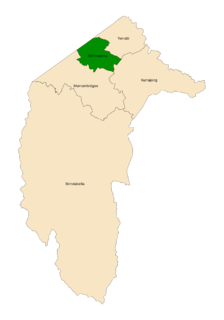
The ACT Greens is a green political party located in the Australian Capital Territory, and a member of the federation of the Australian Greens.

Andrew James Barr is an Australian politician and Chief Minister of the Australian Capital Territory. He has been a Labor Party member for the seat of Molonglo in the ACT Legislative Assembly since 5 April 2006, after being elected on a countback to replace former Treasurer Ted Quinlan, who resigned mid-term. Barr was immediately promoted to Cabinet upon his election. As one of only five Ministers in the Territory government, he held a number of portfolios: Treasurer, Economic Development, Community Services, Tourism, Sport and Recreation, and Tourism and Events. On 11 December 2014 he was elected as Chief Minister after his predecessor, Katy Gallagher, resigned and announced her intention to run for the Senate.
Elections to the Australian Capital Territory Legislative Assembly were held on Saturday, 18 February 1995. The incumbent Labor Party, led by Rosemary Follett, was challenged by the Liberal Party, led by Kate Carnell. For the first time, candidates were elected to fill three multi-member electorates using a single transferable vote method, known as the Hare-Clark system. The result was another hung parliament. However the Liberals, with the largest representation in the 17-member unicameral Assembly, formed Government with the support of Michael Moore and Paul Osborne. Carnell was elected Chief Minister at the first sitting of the third Assembly on 9 March 1995.
Elections to the Australian Capital Territory Legislative Assembly were held on Saturday, 21 February 1998. The incumbent Liberal Party, led by Kate Carnell, was challenged by the Labor Party, led by Wayne Berry. Candidates were elected to fill three multi-member electorates using a single transferable vote method, known as the Hare-Clark system. The result was another hung parliament. However the Liberals, with the largest representation in the 17-member unicameral Assembly, formed Government with the support of Michael Moore, Paul Osborne, and Dave Rugendyke. Carnell was elected Chief Minister at the first sitting of the fourth Assembly on 19 March 1998.

Elections to the Australian Capital Territory Legislative Assembly were held on Saturday, 20 October 2001. The incumbent Liberal Party, led by Gary Humphries, was challenged by the Labor Party, led by Jon Stanhope. Candidates were elected to fill three multi-member electorates using a single transferable vote method, known as the Hare-Clark system. The result was another hung parliament. However Labor, with the largest representation in the 17-member unicameral Assembly, formed Government with the support of the ACT Greens and Democrats. Stanhope was elected Chief Minister at the first sitting of the fifth Assembly on 12 November 2001. The election was conducted by the ACT Electoral Commission and was the first time in Australia's history that an electronic voting and counting system was used for some, but not all, polling places.

Elections to the Australian Capital Territory Legislative Assembly were held on Saturday, 16 October 2004. The incumbent Labor Party, led by Jon Stanhope, was challenged by the Liberal Party, led by Brendan Smyth. Candidates were elected to fill three multi-member electorates using a single transferable vote method, known as the Hare-Clark system. The result was a clear majority of nine seats in the 17-member unicameral Assembly for Labor. It marked the first and so far only time in the history of ACT self-government that one party was able to win a majority in its own right. Stanhope was elected Chief Minister at the first sitting of the sixth Assembly on 4 November 2004. The election was conducted by the ACT Electoral Commission and was the second time in Australia's history that an electronic voting and counting system was used for some, but not all, polling places, expanding on the initial trial of the system at the 2001 ACT election.
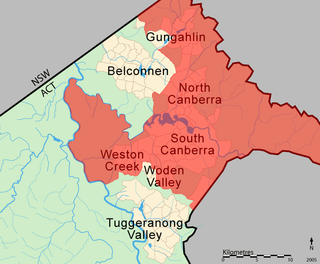
The Molonglo electorate was one of the three electorates for the unicameral 17-member Australian Capital Territory Legislative Assembly between 1995 and 2016. It had seven seats, and was the largest of the three electorates in terms of population.

Elections to the Australian Capital Territory Legislative Assembly were held on Saturday, 18 October 2008. The incumbent Labor Party, led by Jon Stanhope, was challenged by the Liberal Party, led by Zed Seselja. Candidates were elected to fill three multi-member electorates using a single transferable vote method, known as the Hare-Clark system. The result was another hung parliament with Labor winning seven seats, the Liberals six seats and the Greens finishing with four seats, giving the Greens the balance of power in the 17-member unicameral Assembly. On 31 October 2008, after almost two weeks of deliberations, the Greens chose to support a Labor minority government. Consequently, Labor was re-elected to a third consecutive term of government in the ACT. Stanhope was elected Chief Minister at the first sitting of the seventh Assembly on 5 November 2008.
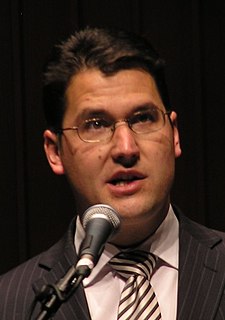
Zdenko Matthew "Zed" Seselja is an Australian politician who has been a Senator for the Australian Capital Territory since 2013, representing the Liberal Party. He was previously a member of the Australian Capital Territory Legislative Assembly from 2004 to 2013, and served as leader of the Canberra Liberals and Leader of the Opposition from 2007 to 2013.
Mary Edith Porter is a former Labor member of the ACT Assembly. She was first elected to the Assembly in October 2004. Immediately prior to that, she was CEO of Volunteering ACT from 1993 until October 2004
Shane Stephen Rattenbury, Australian politician and former Speaker of the ACT Legislative Assembly, is a member of the multi-member unicameral Australian Capital Territory Legislative Assembly representing the electorate of Molonglo for the ACT Greens since 2008. He was the first Speaker in any Parliament in the world representing a Green political party.

Amanda Bresnan is an Australian politician and a member of the Australian Capital Territory Legislative Assembly. Bresnan was elected to the ACT Legislative Assembly representing the electorate of Brindabella for the ACT Greens at the 2008 election and defeated at the 2012 election
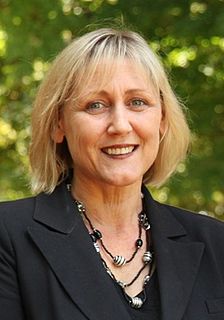
Meredith Hunter, Australian politician, is a former member of the multi-member unicameral Australian Capital Territory Legislative Assembly representing the electorate of Ginninderra for the ACT Greens from 2008 to 2012. She was also the Parliamentary Convenor of the ACT Greens.
Caroline Le Couteur is an Australian politician. She was elected to the Australian Capital Territory Legislative Assembly representing the electorate of Molonglo for the ACT Greens at the 2008 election and defeated at the 2012 election In October 2016, she was re-elected to the assembly representing the new electorate of Murrumbidgee.

A general election for the Australian Capital Territory Legislative Assembly was held on Saturday, 15 October 2016.
This is a list of members of the eighth Australian Capital Territory Legislative Assembly, as elected at and subsequent to the October 2012 election.
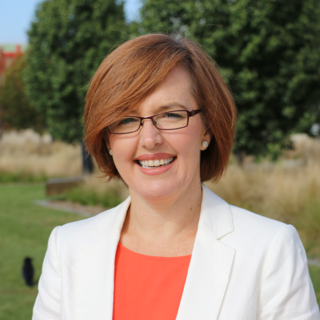
Meegan Fitzharris is an elected Member for the Yerrabi electorate in the Australian Capital Territory Legislative Assembly, as of October 2016. Prior to this, she was the Member for the former electorate of Molonglo after she won a countback to fill the Legislative Assembly seat vacated by former Chief Minister, Katy Gallagher. She is also the Minister for Transport and Municipal Services, Minister for Higher Education, Training and Research and Minister for Health.

A general election for the Australian Capital Territory Legislative Assembly will be held on Saturday, 17 October 2020.




